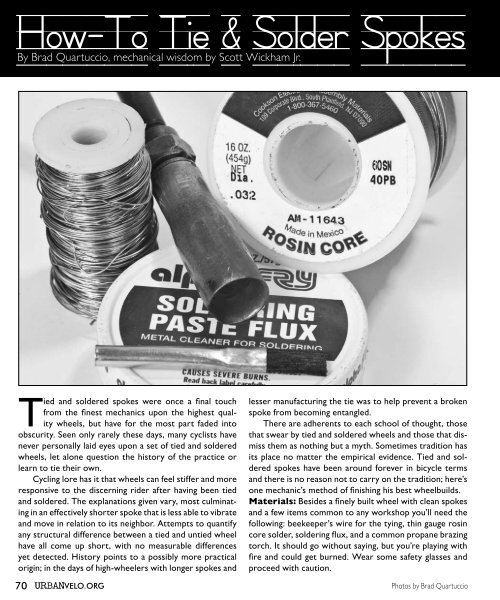HOW-TO TIE & SOLDER SPOKES • A LEGACY OF BIKE ...
HOW-TO TIE & SOLDER SPOKES • A LEGACY OF BIKE ...
HOW-TO TIE & SOLDER SPOKES • A LEGACY OF BIKE ...
Create successful ePaper yourself
Turn your PDF publications into a flip-book with our unique Google optimized e-Paper software.
How-To Tie & Solder Spokes<br />
By Brad Quartuccio, mechanical wisdom by Scott Wickham Jr.<br />
Tied and soldered spokes were once a final touch<br />
from the finest mechanics upon the highest quality<br />
wheels, but have for the most part faded into<br />
obscurity. Seen only rarely these days, many cyclists have<br />
never personally laid eyes upon a set of tied and soldered<br />
wheels, let alone question the history of the practice or<br />
learn to tie their own.<br />
Cycling lore has it that wheels can feel stiffer and more<br />
responsive to the discerning rider after having been tied<br />
and soldered. The explanations given vary, most culminating<br />
in an effectively shorter spoke that is less able to vibrate<br />
and move in relation to its neighbor. Attempts to quantify<br />
any structural difference between a tied and untied wheel<br />
have all come up short, with no measurable differences<br />
yet detected. History points to a possibly more practical<br />
origin; in the days of high-wheelers with longer spokes and<br />
70 URBANVELO.ORG<br />
lesser manufacturing the tie was to help prevent a broken<br />
spoke from becoming entangled.<br />
There are adherents to each school of thought, those<br />
that swear by tied and soldered wheels and those that dismiss<br />
them as nothing but a myth. Sometimes tradition has<br />
its place no matter the empirical evidence. Tied and soldered<br />
spokes have been around forever in bicycle terms<br />
and there is no reason not to carry on the tradition; here’s<br />
one mechanic’s method of finishing his best wheelbuilds.<br />
Materials: Besides a finely built wheel with clean spokes<br />
and a few items common to any workshop you’ll need the<br />
following: beekeeper’s wire for the tying, thin gauge rosin<br />
core solder, soldering flux, and a common propane brazing<br />
torch. It should go without saying, but you’re playing with<br />
fire and could get burned. Wear some safety glasses and<br />
proceed with caution.<br />
Photos by Brad Quartuccio

















